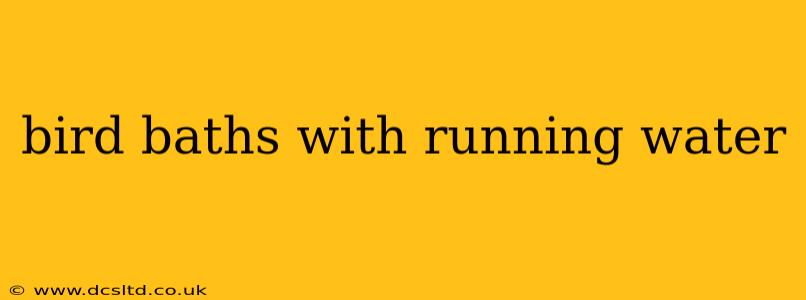Attract a vibrant array of birds to your garden with a bird bath featuring running water. The gentle trickle not only provides fresh, clean water but also adds a captivating element that draws birds in and keeps them coming back for more. This guide explores the benefits of bird baths with running water, different types available, and how to choose the perfect one for your backyard.
Why Choose a Bird Bath with Running Water?
Birds are naturally drawn to moving water. Still water quickly becomes stagnant, breeding bacteria and attracting mosquitoes. A running water bird bath offers several key advantages:
- Cleaner Water: The constant flow ensures the water stays fresh and prevents the growth of harmful bacteria and algae, keeping your feathered friends healthy.
- Increased Attraction: The sound of running water is enticing to birds, drawing them in from a greater distance. It’s a natural call they can’t resist!
- More Frequent Visits: Birds will visit more often to drink and bathe in a continuously replenished water source.
- Prevents Mosquito Breeding: Moving water significantly reduces the risk of mosquito breeding, promoting a healthier environment for both birds and humans.
Different Types of Bird Baths with Running Water
The market offers a variety of bird baths with running water features, each with its own unique design and functionality.
Solar-Powered Bird Baths:
These baths utilize solar energy to power a small pump, creating a gentle recirculating water flow. They are a popular choice due to their ease of use and eco-friendliness. No external power source is required, making them perfect for any location in your garden.
Electric Bird Baths:
Electric bird baths require a direct power connection. They often offer more powerful pumps, creating a stronger stream of water which some birds prefer. However, you'll need access to an electrical outlet nearby.
Gravity-Fed Bird Baths:
These baths utilize a simple reservoir and gravity to create a gentle drip or stream of water. They are typically less expensive and require no electricity or solar power, but the flow rate is usually slower than other types.
DIY Bird Baths with Running Water:
For the crafty bird lover, there are numerous DIY options using recycled materials and simple plumbing components. Online tutorials offer step-by-step guidance on creating your own unique running water bird bath.
What to Consider When Choosing a Bird Bath with Running Water
Choosing the right bird bath depends on several factors:
- Size: Choose a bird bath large enough to accommodate multiple birds simultaneously, especially during peak activity times.
- Location: Select a location that provides easy access for birds, while also offering protection from predators and harsh weather conditions. Consider placing it near trees or shrubs for cover.
- Material: Durable materials such as ceramic, concrete, or metal are best for long-lasting use.
- Maintenance: Regular cleaning is essential to prevent the growth of bacteria and algae. Choose a design that's easy to clean and maintain.
- Budget: Prices vary considerably depending on the features and materials used.
How Often Should I Clean a Bird Bath with Running Water?
Even with running water, regular cleaning is crucial. Aim to clean your bird bath at least once a week, or more frequently during hot, humid weather. Scrub it with a brush and mild soap, rinsing thoroughly with clean water before refilling.
Are Bird Baths with Running Water Worth It?
Absolutely! The benefits of providing birds with a clean, refreshing source of water far outweigh the initial investment. A running water bird bath adds a beautiful and functional element to your garden, providing a vital resource for your local bird population and enriching your own outdoor experience. The joy of watching birds bathe and drink from your creation is unparalleled.
What kind of water is best for a bird bath?
Fresh, clean water is always best. Avoid using chlorinated water, as it can be harmful to birds. Rainwater is ideal, but if you use tap water, allow it to sit for 24 hours to allow the chlorine to dissipate.
How deep should a bird bath be?
The ideal depth for a bird bath is generally no more than 1-2 inches. Birds need to be able to easily reach the water without having to struggle. Shallower is better for smaller birds.
How can I keep my bird bath from freezing in winter?
In colder climates, you may need to take steps to prevent your bird bath from freezing in winter. Consider using a bird bath heater, or simply placing a floating ball in the water to help break up the ice. You can also use a shallow dish for easier access during freezing temperatures.
